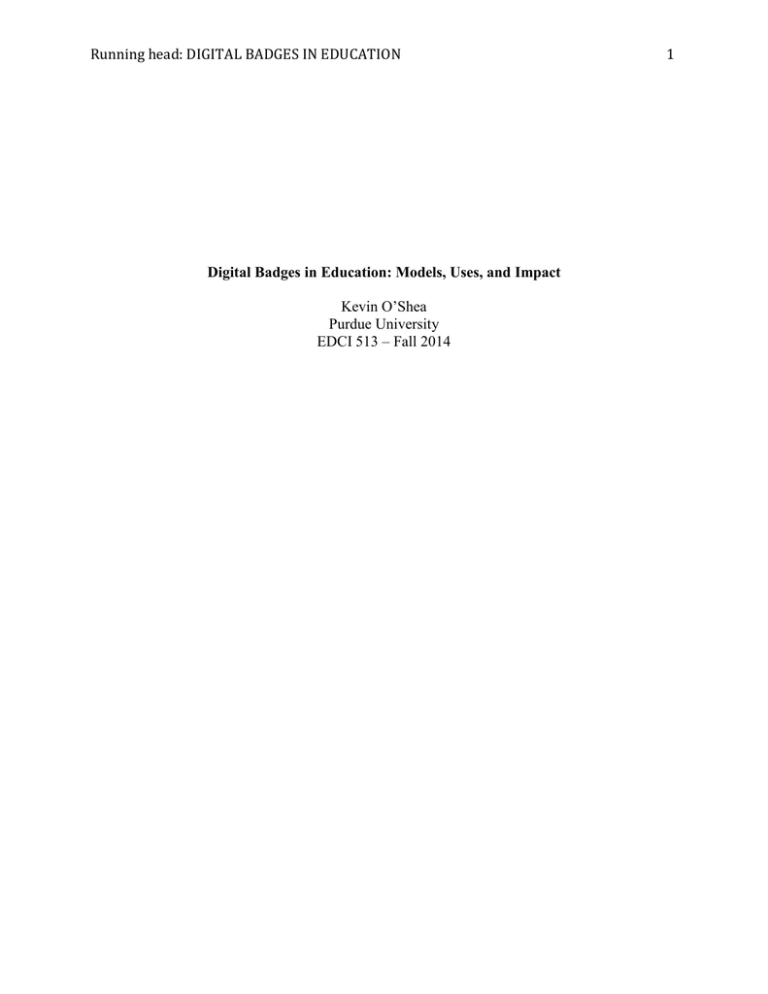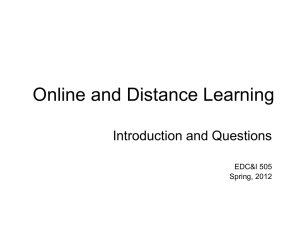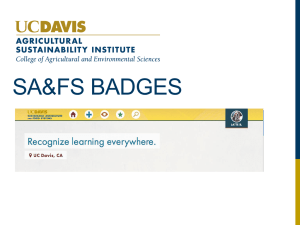edci513_final_researchpaper_oshea
advertisement

Running head: DIGITAL BADGES IN EDUCATION Digital Badges in Education: Models, Uses, and Impact Kevin O’Shea Purdue University EDCI 513 – Fall 2014 1 DIGITAL BADGES IN EDUCATION 2 Abstract Digital badges are a method of showcasing a learner’s earned skills or competencies in education. The idea of utilizing a visual representation of achievement is not new, but the idea of utilizing it as a credential model is one that is currently emerging. Digital badges allow instructors to create measurable course outcomes and explicitly tracked tasks and activities for completion by a learner. The information attached to the badge is specific and explicit metadata including issuer (the who), criteria (the what), and evidence (the how). The purpose of this article is to demonstrate the history, current models and methodology, and future implications of digital badges in higher education. In this article, examples will be covered as to why digital badges are relevant as a model for credentialing all aspects of learning in today’s education field. Keywords: badges, pedagogy, technology, higher education DIGITAL BADGES IN EDUCATION 3 Digital Badges in Education: Models, Uses, and Impact The concept of recognizing earned skills or mastery of specific competencies using a visual metaphor or representation is neither new nor revolutionary. Many youth oriented programs (Boy Scouts of America, Girl Scouts of America) have used badges as a method of awarding badges to members who have completed tasks or activities to show gained knowledge and mastery of specific competencies as a means of tracking growth and increasing motivation. In more recent years, the idea has spread to the virtual realm with the concept of digital badges. Many video game platforms (X-Box, Playstation), social networks (Foursquare), forums (Stack Overflow), and learning platforms (Khan Academy), utilize digital badges as a means of rewarding members that contribute to the general community, complete specific tasks and as a method of motivating specific behaviors. Open Badges Infrastructure (OBI) The Mozilla Foundation (n.d.), the makers of Firefox and other initiatives, have created an open specification for creating, issuing, and displaying open badges online through the Open Badges Infrastructure (OBI). Mozilla's Open Badges require the embedding of metadata directly to the image of the digital badge, allowing for deeper context as to how, specifically, a learner has earned their mastery (The Mozilla Foundation, Peer 2 Peer University, & The MacArthur Foundation, 2012). The potential value argued by the Mozilla Foundation et al. (2012), of a digital badge is that rather than having implicit meaning, compared to the current credential model, it has very explicit meaning to the instructor, learner, and potential third-party evaluators. DIGITAL BADGES IN EDUCATION 4 Attached to each digital badges, through the use of metadata, are the issuer (who), criteria (what), and the evidence (how) of what occurred to capture that learning. Digital badges, as a potential credential model in education, offer a “fine-grained” approach capturing and assessing learning outcomes. (Bowen & Thomas, 2014) Digital Badge Types & Models Utilizing methods of rewarding behavior or achievement as a means to further motivation is not an unknown concept in education. Principles of behaviorist theory focus on the ability to strengthen or weaken a response through reinforcement (Driscoll, 2005). Many initial uses of digital badges have taken a reinforcement approach to issuing recognition of achievement. Video games are an often-used example of this early model of awarding specific achievements as a motivating factor to complete the next round of tasks or levels. It has evolved to also allow gamers to share their in-game achievement with friends and peers outside of the game through online portfolio or profile. As mentioned by Abramovich, Schunn, & Higashi (2013), this model strictly is meant to encourage more time spent playing the game. From the work of O’Shea and Wright (2014), two models of digital badges have emerged in their collaboration with faculty at Purdue University. Issuing a call for collaborators in in the spring of 2012 (Thomas, 2012), O’Shea and Wright as members and researchers of the Informatics team worked directly with early adopters interested in badging in education. O’Shea and Wright (2014) assisted in the instructional design and creation of tasks needed to earn digital badges, and found that the majority of badges fell into one of two categories of ‘Participation Badges’ or ‘Skills Badges’. As seen in Figure #1, the first classification is that of ‘Participation Badges’. Participation badges centered on activities that were surface level only loosely connected to specific course DIGITAL BADGES IN EDUCATION 5 defined outcomes and objectives. An example of types of activities used for participation badges would include awarding badges for high attendance, or attending events. These types of badges encompass surface, low-level learning. The second classification was that of skills-based badges. Skills badges attempt to capture specific goals and learning outcomes through the activities completed by the learner. These badges represent a deeper form of learning where students can pursue a greater understanding of a particular topic. Figure 1. Participation Badges & Skill Badges. This figure illustrates the difference between two identified types of digital badges. This isn’t to say that one type of badge is inherently better than the other, but that they can be used together to meet the needs of the students and their learning goals. O’Shea and Wright (2014) through their collaboration and support of instructors and users of Purdue’s badge platform, Open Passport (http://openpassport.org), developed a low-tech approach to conceptualizing skills and outcomes-based badges. Through the collaboration and experience in designing instructional digital badges, O’Shea & Wright (2014) created a ‘Digital Badge Worksheet’. This worksheet was created to utilize a step-by-step approach for an instructor new to the concept of digital badges by ideating on instructional goals and specific learner tasks needed for completion prior to learning a new software application. The worksheet lists six (6) DIGITAL BADGES IN EDUCATION 6 categories for an instructor to reflect and fill out pertinent information as an exercise to illuminate the key areas of concern when creating digital badges. The top categories of the worksheet are required components of the Mozilla Foundation’s (n.d.) Open Badge Infrastructure. The categories of learning outcomes, learning activities, and required evidence and assessment are additions added by O’Shea & Wright (2014) as aspects of the instructional design process for digital badges in education. Learning Outcomes The ability to demonstrate acquired knowledge, skills, and attitude is essential to the outcomesbased learning model in education (Spady, 1994). Spady (1994) claims that acquired knowledge from the content must be demonstrated. The Digital Badge Worksheet from O’Shea & Wright (2014), requires instructors and designers to ideate and craft measurable learning outcomes with the goal of thinking about the specific things learners should be able to demonstrate from earning the digital badge. Learning Activities Once the Learning Outcomes have been defined, the specific activities for completion of the digital badge need to be created. These activities should be directly related to the prior defined outcomes (O’Shea & Wright, 2014). Required Evidence & Assessment Criteria A core component to open badges defined by the Mozilla Foundation et al. (2012), is the attached criteria and learner evidence that provides an explicit verification of requirements, assessment, and completion of the badge. O’Shea and Wright (2014) identified this as a challenging aspect for first time users of digital badge platforms. Current Implementations of Digital Badges at Purdue University DIGITAL BADGES IN EDUCATION 7 From the Mozilla Foundation’s Badge Issuer wiki (n.d.) \badges as a model of measuring performance or behavior are being issued across multiple organizations from NASA, the Smithsonian, Pixar, and many more. . Purdue University has provided a digital badging platform, Open Passport, as a means for instructors to create, assess, and issue digital badges. Digital badges are earned by learners through the completion of specific tasks, known as challenges. Challenges can be submitting content (documents, files, web links, etc.), take quizzes, submitting a survey, or manual instructor approval. (Harrison, Randall, and West, 2013) The baccalaureate-nursing program at Purdue has implemented nine (9) digital badges in the sophomore-level 'Essentials of Nursing' course (Thomas, 2014). This professional program at Purdue has revamped their curriculum to align with the Institute for Healthcare Improvement (IHI) and their online course, IHI Open School. Students follow online e-learning modules based around specific areas in healthcare service and are assessed through the IHI Open School system. Upon completion of each module, students are given an online certificate that can be printed or downloaded as a PDF. Professors Pamela Karagory and Kristen Kirby identified a need of collecting these certifications, student research projects, and reflections outside of the IHI Open School platform (Thomas, 2014). Working with the team at Studio by Purdue (http://purdue.edu/studio), Professors Karagory and Kirby were able to create digital badges that aligned to their curriculum outcomes. DIGITAL BADGES IN EDUCATION Figure 2: Digital badges issued in Purdue University’s School of Nursing. This figure illustrates the required digital badges for students in Nursing 220 at Purdue. Collaboration between Purdue University and the Nanohub organization, an online course platform for nanotechnology related topics, has yielded an approach of credentialing worldwide learners with digital badges. Users from around the world can sign up and take selfpaced (free), and instructor-led courses (for a fee) (Tally & Bowen, 2012). Originally students were given certificates of completion. However, after feedback from learners it was identified that certificates of completion did not contain much explicit information of the learning process and it was suggested that digital badges could be used instead. Now, learners of NanohubU will earn digital badges capturing the criteria and evidence of their learning in the online courses. 8 DIGITAL BADGES IN EDUCATION 9 Figure 3: NanoHub U digital badges. This figure illustrates digital badges given in the Purdue hosted open online courses through the NanHub organization. Limitations in Literature & the Future Digital badges as a research area are ripe with prospect as models and theories of usage have yet to be fully fleshed out. Much of the current literature centers on the proposed potential that digital badges may or may not have in education. Many questions about the efficacy of digital badges as a true measure of learning exist, such as the thoughts from MIT Professor, Mitch Resnick quoted in Campus Technology, concerning the idea that students will focus the majority of their time on gaining badges instead of synthesizing learned information into meaningful connections (Watters, 2012). Other gaps in the today’s current research field, but still worthy of consideration in further exploration or conversation in the realm of digital badges and learning are related to the idea of badge proliferation, protecting student privacy, and the full implications of replacing the current credential model in education. ‘Official’ Badges DIGITAL BADGES IN EDUCATION 10 The idea of badge proliferation is one area of concern, as it requires the instructor to ask the question ‘Are all badges created equal?’. Much like the current credential model, a governing body may be in need of approving high level, high stakes badges at institutions of higher education to ensure a standard of accreditation. However, what does that mean for specific departments and individual instructors? Going forward, it will be imperative to discuss the impact of ‘official’ university issued badges, and those from an individual instructor. FERPA: Family Educational Rights & Privacy Act As more programs enlist the idea of a visual and explicit credential to capture learning and earned competencies, what does the individual learner have to agree to share or display? The Family Educational Rights & Privacy Act, also known as FERPA, is the set of government guidelines of the handling of private data for enrolled students in education (FERPA, 2014). In an ever-shifting world of tricky privacy agreements, and data breaches, it will be the responsibility of the instructor to consider the ramifications of asking a student to explicitly post their completed work to the entirety of the World Wide Web. Many applications that issue digital badges offer cascading options of privacy for the learner, but to this writer, it will ultimately be the responsibility of the instructor to reflect on the appropriateness of the assignment or task and the impact it will place on the learner if/when shared with the world. Conclusion & Further Discussion Research around motivation and badges will be crucial as a next step in measuring the effectiveness of using an explicit means of showcasing earned skills and competencies. As of 2014, there is yet to be a fully developed, or recognized curriculum that awards digital badges in place of or an alternative to the traditional grading model. Further research will be needed to truly measure and observe the impact that digital badges potentially have in the realm of DIGITAL BADGES IN EDUCATION 11 education, and if they live up to the promise of capturing all forms of learning (Bowen & Thomas, 2014). With the goal from the Mozilla Foundation et al. (2012) to impact the current credentialing model for measuring obtained knowledge, it will be imperative to create badges that allow for measurable outcomes that capture the learner’s ability to demonstrate obtained knowledge, skills, and attitude Spady, 1994). Another area of future research and understanding will be that of the motivation of learners in this alternative credentialing model and if the explicit presentation of learning outcomes, required criteria, and attached evidence of completion have any influence the learning process or completion of digital badges (Harrison, Randall, and West, 2013). The final, and most unclear impact of digital badges that will need to be measured is on the effect they may or may not have for learners to successfully obtain future employment. Harrison et al., (2013) identify the need to effectively poll and measure potential perceptions from employers on the value of reviewing badges as an appropriate portfolio asset. Ertmer and Newby (2013) mention the need for instructors and designers to be prepared for the new learning design challenges that technology is starting to highlight. With the call for an increase in skills and competency-based learning, instructional design and learning theory are needed to properly address and implement solutions. Even Purdue's President has joined the conversation (Daniels, 2014), challenging the academic community at the University to find a competency-based instructional model. One potential method of measuring and showcasing skills based learning is through the area of digital badges, but to truly understand their impact, there is much left to research and measure. DIGITAL BADGES IN EDUCATION 12 DIGITAL BADGES IN EDUCATION 13 References Abramovich, S., Schunn, C., & Higashi, R. (2013). Are badges useful in education?: it depends upon the type of badge and expertise of learner. Educational Technology Research and Development, 61(2), 217–232. doi:10.1007/s11423-013-9289-2 Bowen, K., & Thomas, A. (2014). Badges: A Common Currency for Learning. Change: The Magazine of Higher Learning, 46(1), 21–25. doi:10.1080/00091383.2014.867206 Daniels, M. (2014, January). An Open Letter to the People of Purdue - January 2014. Retrieved from http://www.purdue.edu/president/email/2014/1401-med-openletter.html Driscoll, M. P. (2005). Psychology of learning for instruction. Boston: Pearson Allyn and Bacon. Ertmer, P. A., & Newby, T. J. (2013). Behaviorism, Cognitivism, Constructivism: Comparing Critical Features From an Instructional Design Perspective. Performance Improvement Quarterly, 26(2), 43–71. doi:10.1002/piq.21143 Family Educational Rights and Privacy Act (FERPA). (2014, June 2). [Guides]. Retrieved October 12, 2014, from http://www2.ed.gov/policy/gen/guid/fpco/ferpa/index.html Mozilla Foundation. (n.d.). Badges/Issuers - MozillaWiki. Retrieved October 10, 2014, from https://wiki.mozilla.org/Badges/Issuers Mozilla Foundation. (n.d.). Mozilla Foundation: Open Badges About Page. Retrieved October 10, 2014, from http://openbadges.org/about/ Mozilla Foundation, Peer 2 Peer University, & in collaboration with The MacArthur Foundation. (2012, January 23). Open badges for lifelong learning. Retrieved from https://wiki.mozilla.org/images/b/b1/OpenBadges-Working-Paper_092011.pdf O’Shea, K., & Wright, C. (2014, May 1). Digital Badges and Outcomes-Based Learning | EDUCAUSE.edu. Educause Connect Baltimore 2014. Retrieved from DIGITAL BADGES IN EDUCATION 14 http://www.educause.edu/events/educause-connect-baltimore/2014/digital-badges-andoutcomes-based-learning O’Shea, K., & Wright, C. (2014, May 1). Digital Badge Worksheet. Retrieved from http://www.educause.edu/sites/default/files/library/presentations/EC143/SESS20/DigitalBadgeW orksheet_EXAMPLE.pdf Randall, D., Harrison, J. B., & West, R. (2013). Giving Credit Where Credit Is Due: Designing Open Badges for a Technology Integration Course. TechTrends, 57(6), 88–95. doi:10.1007/s11528013-0706-5 Spady, W. G. (1994). Outcome-Based Education: Critical Issues and Answers. ERIC. Tally, S., & Bowen, K. (2012, September 11). Digital badges show students’ skills along with degree. Retrieved from http://www.purdue.edu/newsroom/releases/2012/Q3/digital-badges-showstudents-skills-along-with-degree.html Thomas, A. (2014, April 17). Nursing faculty and students implement Passport badges to measure learning, achievement. Retrieved April 23, 2014, from http://www.itap.purdue.edu/newsroom/news/140417_passport_nursing.html Thomas, A. (2012, April 23). Professor, ITaP seek faculty to collaborate on new learning technology. Retrieved from http://www.itap.purdue.edu/newsroom/news/professor_itap_seek.html Watters, A. (2012). Show Me Your Badge. Campus Technology Magazine, 26(4), 8–12.





